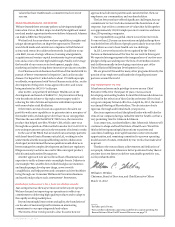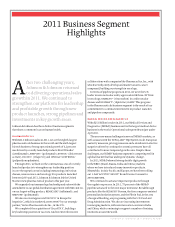Johnson and Johnson 2011 Annual Report Download - page 15
Download and view the complete annual report
Please find page 15 of the 2011 Johnson and Johnson annual report below. You can navigate through the pages in the report by either clicking on the pages listed below, or by using the keyword search tool below to find specific information within the annual report.
JOHNSON & JOHNSON 2011 ANNUAL REPORT 13
When consumers in
France unwrap a LE PETIT
MARSEILLAIS® bar of
soap, they may notice an
additional logo: that of the
GreenPalm program. LE PETIT
MARSEILLAIS® recently began
using the GreenPalm logo on
packaging to highlight efforts
supporting sustainable palm
oil production.
Palm oil and ingredients
derived from palm oil are
commonly used in personal
care products such as soaps,
lotions, shampoos and creams.
The oil, which comes from the
fruit of the oil palm tree, is also
used in the production of food
and biofuel. The demand for
palm oil is increasing at an
unsustainable rate, causing
damage to rainforests and
threatening the environments
of several endangered species.
“Even though we represent a
small portion of global palm oil
usage—less than 0.2 percent in
2011—we joined the
Roundtable for Sustainable
Palm Oil (RSPO) in 2006 to
help make a difference in the
sustainability of this important
ingredient,” says Paulette Frank,
Vice President, Sustainability
and Environment, Health and
Safety, Johnson & Johnson
Family of Consumer Companies.
In 2010 and 2011,
sustainable palm oil certificates
equal to 100 percent of our
estimated palm oil use were
purchased from the GreenPalm
program, which is endorsed by
the RSPO.
“The GreenPalm program
allows us to demonstrate our
commitment to our Healthy
Future 2015 goal of sourcing
all palm oil and palm oil
derivatives from certified
sustainable sources,” says
Simon Perry, Sourcing
Manager, Johnson & Johnson
Family of Consumer Companies.
To achieve the 2015 goal,
Johnson & Johnson has a
global palm oil sourcing
strategy that includes engaging
our suppliers, collaborating
with nongovernmental
organizations (NGOs) and
supporting projects to increase
the availability of certified
sustainable palm oil supplies.
For example, a partnership with
the Dutch NGO Solidaridad
trains farmers in sustainable
palm oil farming techniques.
“We are doing everything
we can to accelerate and
promote the growth of
sustainable palm oil,” says
Frank. “We’re a small user, but
we have a big voice.”
McNeil Consumer Healthcare
continues to make progress
against commitments to
return high-quality products to
shelves for consumers.
Shipments have resumed
for a number of adult and
children’s TYLENOL®
products. We anticipate that
key selected products will
continue to be reintroduced
throughout 2012. A number
of Johnson & Johnson
manufacturing facilities—
and hundreds of supply
chain associates—have been
involved in the effort to return
these trusted brands to store
shelves.
Work also continues to
outfit the manufacturing
facility in Fort Washington,
Pa., with state-of-the-art
equipment and processes
to provide quality products
to consumers. Upon its
reopening, the site will be
a world-class facility for
manufacturing over-the-
counter liquid medicines.
Supporting Sustainable Sourcing
Returning
Quality
McNeil
Products
REDUCING OUR IMPACT As part of efforts to encourage sustainable palm oil supply and sourcing,
Johnson & Johnson works with organizations that engage in sustainable palm oil farming practices.
























